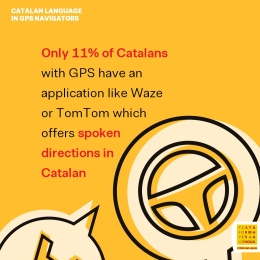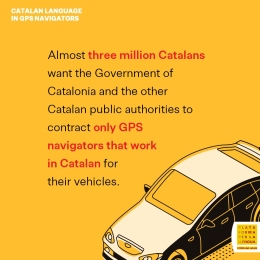1,690,000 million Catalans would change their GPS navigator to have one that offered voice directions in Catalan. This is one of the main statistics drawn from the survey commissioned form the company GESOP by Plataforma per la Llengua, which also concludes that, in the case of users of Google Maps, almost half - around a million - would be prepared to make the change.
At the moment, Google Maps is the most popular navigation app among Catalans. Of the approximately 65% who use a GPS navigator with voice directions, just over half choose the Google app. None of the other navigators reaches the 7% of users with respect to the total who have GPS. That includes both those who have a GPS fitted in their car and those who have an independent GPS - a mobile app connected to the vehicle's screen or one without a connection.
The Google navigator offers the graphic interface in Catalan. In other words, users can see written instructions and messages on the screen in that language. However, Google Maps does not yet offer the possibility of hearing voice directions in Catalan and prevents users who have the interface in Catalan receiving oral directions. This means that to enjoy this possibility users have to configure the app in another language. For this reason, although the app has some options in Catalan, only 13.7% of people have it in that language.
The GESOP survey also makes it clear that the navigators that do offer voice directions in Catalan are still not very popular. TomTom, which offers a free and a paid-for version, is used by only 5% of users who have a navigator. Meanwhile, the Waze app, which only has a free version, is used by only 6.5% of users. It is paradoxical that Waze includes Catalan and Google Maps does not, taking into account that Waze was bought by Google in 2013. The two therefore form part of the same business group.
The figures reveal another paradox: many Catalan-speakers do not have these navigators set up in Catalan. About 35% have TomTom and Waze configured in Spanish and almost 11% have Waze in English. Based on these figures and awaiting information about why they do not have then in Catalan, we now need to analyse the other factors which explain that both Waze and TomTom are still little used, when half Google Maps users are considering changing GPS to hear voice directions in Catalan and these navigators already offer them. There could be various reasons for this. For example, the Google navigator is the one offered by default by the Android system, which is used by 70% of Catalans, and it does not have to be specifically downloaded. In addition, most people are now used to using it, on the computer too. And Google Maps performs better than Waze and TomTom, which are still not very well-known navigators.
Three million Catalans want the public authorities to contract only navigation systems in Catalan
One of the figures provided by the survey is that almost three million Catalans (2,940,000) want the Government of Catalonia and the other Catalan public authorities to contract only GPS navigators that work in Catalan for their vehicles. This would include all official cars, as well as police and fire service vehicles, being given navigators that offer voice directions in Catalan.
This language requirement, when it comes to contracting a navigation system, is supported by more than half Catalan-speakers (54%) and almost 40% of Spanish-speakers. Sympathisers with Junts per Catalunya (73%) and the CUP (71%) are clear supporters of it, along with more than half of Esquerra Republicana supporters (52%). By age groups, the ones who most support the measure are people aged over 60 (50.4%), followed by those between 30 and 44 years, those between 45 and 59 and, finally, those between 16 and 29 years, who are the least in favour (41.2% support).






